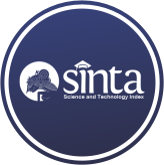Analisis Prediksi Curah Hujan Bulanan Wilayah Kota Sorong Menggunakan Metode Multiple Regression
(1) Universitas Amikom Yogyakarta
(2) Universitas Amikom Yogyakarta
(3) Universitas Amikom Yogyakarta
(*) Corresponding Author
Abstract
Full Text:
PDFReferences
B. Suma, “Implementasi Machine Learning Di Dalam Prediksi Cuaca Disusun sebagai salah satu syarat untuk kelulusan Program Strata 1 di Program Studi Teknik Informatika Universitas Pasundan Bandung oleh : BANDUNG SEPTEMBER 2020,” no. September 2020, 2021, doi: 10.13140/RG.2.2.16086.47680.
I. Jhonson Arizona Saragih et al., “Prediksi Curah Hujan Bulanan Di Deli Serdang Menggunakan Persamaan Regresi Dengan Prediktor Data Suhu Dan Kelembapan Udara,” J. Meteorol. Klimatologi dan Geofis., vol. 7, no. 2, pp. 6–14, 2020.
A. Fadholi, “Persamaan regresi prediksi curah hujan bulanan menggunakan data suhu dan kelembapan udara di Ternate,” J. Stat., vol. 13, no. 1, pp. 7–16, 2013.
R. Jati, “Banjir dan Longsor Kota Sorong Akibatkan Tiga Orang Meninggal Dunia,” 2020. [Online]. Available: https://bnpb.go.id/berita/Banjir dan Longsor Kota Sorong Akibatkan Tiga Orang Meninggal Dunia. [Accessed: 01-Jan-2022].
H. Muhamad, I. Cholissodin, and B. D. Setiawan, “Optimasi Support Vector Regression (SVR) Menggunakan Algoritma Improved-Particle Swarm Optimization (IPSO) untuk Peramalan Curah Hujan,” J. Pengemb. Teknol. Inf. dan Ilmu Komput. Univ. Brawijaya, vol. 1, no. 11, pp. 2548–964, 2017.
N. Anusha, M. Sai Chaithanya, and G. Jithendranath Reddy, “Weather Prediction Using Multi Linear Regression Algorithm,” IOP Conf. Ser. Mater. Sci. Eng., vol. 590, no. 1, 2019, doi: 10.1088/1757-899X/590/1/012034.
A. Luthfiarta, A. Febriyanto, H. Lestiawan, and W. Wicaksono, “Analisa Prakiraan Cuaca dengan Parameter Suhu, Kelembaban, Tekanan Udara, dan Kecepatan Angin Menggunakan Regresi Linear Berganda,” JOINS (Journal Inf. Syst., vol. 5, no. 1, pp. 10–17, 2020, doi: 10.33633/joins.v5i1.2760.
E. Dewi et al., “Prediksi Curah Hujan Di Kabupaten Majalengka Dengan Menggunakan Algoritma Regresi Rainfall Prediction in Majalengka District Using Regression Algorithm,” Inf. , vol. 67, no. 1, 2019.
M. Kafil, “Penerapan Metode K-Nearest Neighbors Untuk Prediksi Penjualan Berbasis Web Pada Boutiq Dealove Bondowoso,” JATI (Jurnal Mhs. Tek. Inform., vol. 3, no. 2, pp. 59–66, 2019, doi: 10.36040/jati.v3i2.860.
S. Aftab, M. Ahmad, N. Hameed, M. S. Bashir, I. Ali, and Z. Nawaz, “Rainfall prediction in Lahore City using data mining techniques,” Int. J. Adv. Comput. Sci. Appl., vol. 9, no. 4, pp. 254–260, 2018, doi: 10.14569/IJACSA.2018.090439.
S. Putramulyo and S. Alaa, “Prediksi Curah Hujan Bulanan Di Kota Samarinda Menggunakan Persamaan Regresi Dengan Prediktor Data Suhu dan Kelembapan Udara,” Eig. Math. J., vol. 2, no. 2, p. 13, 2018, doi: 10.29303/emj.v2i2.20.
N. Binternagel, “Adaptasi dan Mitigasi Perubahan Iklim Global,” no. October, 2009.
A. Ardhitama, “Simulasi Prakiraan Jumlah Curah Hujan Dengan Menggunakan Data Parameter Cuaca (Study Kasus Di Kota Pekanbaru Tahun 2012),” J. Sains Teknol. Modif. Cuaca, vol. 14, no. 2, p. 111, 2013, doi: 10.29122/jstmc.v14i2.2690.
D. Prakoso, “Analisis Pengaruh Tekanan Udara, Kelembaban Udara Dan Suhu Udara Terhadap Tingkat Curah Hujan Di Kota Semarang,” pp. 1–77, 2018.
Y. S. Swarinoto and S. Sugiyono, “Pemanfaatan Suhu Udara Dan Kelembapan Udara Dalam Persamaan Regresi Untuk Simulasi Prediksi Total Hujan Bulanan Di Bandar Lampung,” J. Meteorol. dan Geofis., vol. 12, no. 3, pp. 271–281, 2011, doi: 10.31172/jmg.v12i3.109.
P. S. A. Husaini Usman, Pengantar statistika, Ed. 2. Jakarta : Bumi Aksara, 2006., 2006.
Sudjana, Metode statistika. Bandung : Tarsito, 2002.
I. R. Rumahorbo, “Persamaan Regresi Prediksi Curah Hujan Bulanan Menggunakan Data Suhu dan Kelembapan Udara di Bengkulu,” Pros. Semin. Pendidik. Mat. dan …, vol. 2, no. 2721, pp. 1–11, 2020.
I. Russell and Z. Markov, “An Introduction to the Weka Data Mining System (Abstract Only),” vol. 18, no. 3, pp. 742–742, 2017, doi: 10.1145/3017680.3017821
DOI: http://dx.doi.org/10.30645/j-sakti.v6i1.455
Refbacks
- There are currently no refbacks.
J-SAKTI (Jurnal Sains Komputer & Informatika)
Published Papers Indexed/Abstracted By:
Jumlah Kunjungan :











